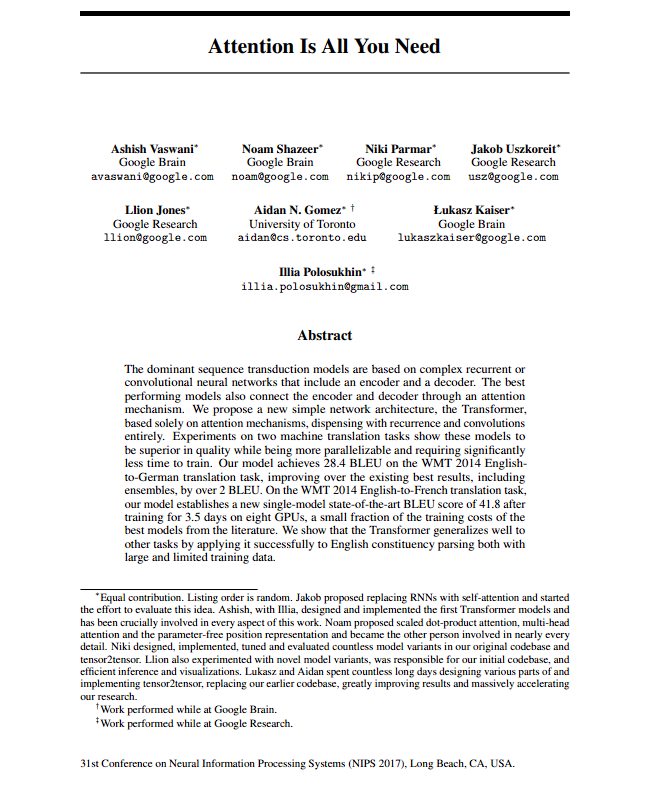Journey of GenAI Revolution
The Remarkable Evolution of Generative AI
From humble beginnings to today's powerful language models, the journey of Generative AI has been nothing short of revolutionary. Embark on a voyage through the pivotal moments and groundbreaking achievements that have not only redefined technology but also reshaped our understanding of intelligence itself.
The dawn of modern Generative AI was heralded in 2017 with the seminal paper "Attention Is All You Need," which unveiled the Transformer architecture. This wasn't merely an academic milestone; it was a paradigm shift that paved the way for the advanced language models we rely on today—from BERT's nuanced understanding to GPT-4's astonishing capabilities.
Join me as I chronicle the most transformative moments in the history of Generative AI that not only shaped the history of AI but also the history of the mankind forever.
- The Early Breakthroughs (2017-2019)AlphaGo ZeroUnlike its predecessor, AlphaGo Zero learned solely through self-play, starting with random moves and developing sophisticated strategies without any human input. This breakthrough showed that AI could develop superhuman abilities from first principles.Other references: Read the Paper (full text behing paywall)
Birth of TransformersThis groundbreaking paper by Vaswani et al. introduced a novel architecture that processes all input tokens in parallel using self-attention mechanisms, replacing the traditional recurrent neural networks. This innovation became the foundation for virtually all modern language models.
Launch of BERT and GPTBERT's bidirectional approach revolutionized how AI understands context in language, while GPT demonstrated the potential of generative pre-training for text generation. These models set new standards in natural language processing tasks.Other references: Google AI Blog
Release of GPT-2The initial limited release sparked discussions about AI ethics and safety, as the model's capabilities in generating convincing synthetic text raised concerns about potential misuse. This marked one of the first instances where AI capabilities were deliberately withheld due to societal impact concerns.Other references: OpenAI Research
The Scaling Era (2020-2022)GPT-3 ReleasedOpenAI launches GPT-3, setting new benchmarks in language generation with unprecedented scale and capabilities.Other references: OpenAI GPT-3
AlphaFold 2DeepMind achieves a breakthrough in predicting protein structures, revolutionizing biological research and drug discovery.Other references: DeepMind AlphaFold
DALL·E and LaMDAOpenAI introduces DALL·E for generating images from text, while Google unveils LaMDA, focusing on natural, open-ended conversational AI.Other references: DALL·E Research
The ChatGPT Revolution (2022-Present)Stable DiffusionStability AI releases Stable Diffusion as open source, making high-quality AI image generation accessible to everyone.
Delighted to announce the public open source release of #StableDiffusion! Please see our release post and retweet! https://t.co/dEsBX7cRHw Proud of everyone involved in releasing this tech that is the first of a series of models to activate the creative potential of humanity
— @EMostaque August 22, 2022Other references: Stable Diffusion Public Release
Perplexity AI FoundedFounded in August 2022, Perplexity AI is a conversational search engine designed to provide real-time, AI-powered answers. Leveraging large language models, it cites sources within its responses to maintain transparency. The company, based in San Francisco, operates on a freemium model, with its Pro version offering advanced AI integrations, including GPT-4, Claude 3.5, Grok-2, and proprietary Perplexity models. In 2024, it gained significant traction with 15 million monthly users and expanded its enterprise offerings. Perplexity is one of the first companies built on LLMs to reach unicorn status.
ChatGPT LaunchOpenAI releases ChatGPT, powered by GPT-3.5, transforming how people interact with AI. The chatbot gained unprecedented popularity, reaching 100 million users within just two months of launch - making it the fastest-growing consumer application in history. Its natural conversation abilities and broad knowledge base made AI accessible to the general public in a way never seen before.Other references: Launch Announcement, 100M Users in 2 Months
GPT-4 ReleaseOpenAI releases GPT-4, a significant upgrade featuring multimodal capabilities allowing it to understand both text and images. The model demonstrated remarkable improvements in reasoning, creativity, and technical understanding, passing various professional exams and showing human-level performance on many academic benchmarks. GPT-4 also introduced new safety features and reduced hallucinations compared to its predecessor.Other references: GPT-4 Release, Technical Report
Claude 2Anthropic launches Claude 2, featuring sophisticated reasoning abilities and significantly expanded context windows.Other references: Launch Blog, Technical Details
Leadership shakeup at OpenAIIn what felt like a tech soap opera meets corporate thriller, OpenAI treated the world to the most dramatic long weekend in recent tech history. From unexpected CEO departures to midnight negotiations, and enough plot twists to make Netflix jealous, the AI world watched in suspense as OpenAI demonstrated that even them as an AI company aren't immune to good old human drama. We know we've reached AGI when the AI itself starts writing the scripts this good.
Sam Altman's OpenAI DepartureOpenAI's CEO Sam Altman unexpectedly departs, triggering industry-wide discussions about AI governance and corporate stability.
The decision led to significant unrest within OpenAI. Employees rallied behind Altman, with over 700 (the majority of the workforce) signing a letter demanding his reinstatement.
They threatened to resign en masse if the board didn't reverse its decision.
i loved my time at openai. it was transformative for me personally, and hopefully the world a little bit. most of all i loved working with such talented people. will have more to say about what's next later. 🫡
— @sama November 17, 2023Other references: Sam Altman's Tweet, OpenAI Leadership Transition
Sam Altman Returns to OpenAIAfter a brief but intense period of uncertainty, Sam Altman returns as CEO of OpenAI with a new initial board, marking a significant moment in AI governance and corporate leadership. Microsoft, OpenAI’s largest investor, played a key role in the unfolding drama. As chaos ensued, Microsoft announced it had hired Sam Altman and Greg Brockman (OpenAI’s co-founder and former president) to lead a new advanced AI research division. This move put pressure on OpenAI’s board, as the two companies are deeply intertwined. It was a whirlwind of events that underscored both the importance and fragility of leadership in transformative tech fields.Sam Altman is back as CEO, Mira Murati as CTO and Greg Brockman as President. OpenAI has a new initial board. Messages from @sama and board chair @btaylor
— @OpenAI November 30, 2023Other references: OpenAI: Sam Altman Returns
Google DeepMind Unveils GeminiLaunched in December 2023, Gemini is Google DeepMind's flagship family of multimodal large language models (LLMs), succeeding PaLM 2. It processes text, images, audio, video, and code simultaneously, setting a new benchmark with advanced capabilities. Gemini boasts an extremely large context window of up to one million tokens in its latest versions, enabling it to handle extended conversations, analyze lengthy documents, or process long-duration audio and video files without losing coherence. This feature opens doors to applications like reviewing entire books, summarizing multi-hour videos, or working with extensive source code. The model family includes Ultra, Pro, and Nano versions, tailored for enterprise tasks, edge devices, and everyday use. Its high performance on benchmarks like MMLU and integration across Google products (e.g., Bard, Pixel devices, Google Workspace) make it a direct competitor to OpenAI's GPT-4.Other references: Google DeepMind Gemini Official Page, Gemini Launch Press Release
Custom GPTsOpenAI launches Custom GPTs, enabling users to create specialized AI assistants for specific tasks and domains.Other references: Introducing GPTs
Flux model by Black Forest LabsBlack Forest Labs launched Flux, a cutting-edge partly open source text-to-image model developed by the same team behind Stable Diffusion. With its hybrid architecture combining multimodal and parallel diffusion transformers, Flux can generate highly photorealistic images from text prompts. The model's success was bolstered by its integration into xAI's Grok chatbot on X (formerly Twitter), bringing image generation to mainstream social media. Flux's advanced capabilities placed it on par with industry giants like DALL-E 3 and MidJourney, pushing the boundaries of AI-driven creativity and raising new ethical debates about image generation.Today we release the FLUX.1 suite of models that push the frontiers of text-to-image synthesis. read more at https://t.co/49zTUK8Q5V pic.twitter.com/hmcKRIlizn
— @bfl_ml August 1, 2024Other references: Custom GPTs
NotebookLM Launched by Google LabsWhile originally released already in 2023 Google NotebookLM goes viral in September 2024 being the number one discussed AI tool of the month. It is a research and note-taking tool developed by Google Labs. It leverages the Google Gemini AI to assist users in analyzing and interacting with their documents. NotebookLM can generate summaries, explanations, and answers based on uploaded content, and also includes features like 'Audio Overviews,' which summarize documents in a conversational, podcast-like format. Initially targeted at researchers, the tool has since gained traction among companies and students for its versatile functionality.Other references: NotebookLM Official Page
Looking Ahead: The Future of GenAI
As we look to the future, several exciting developments are on the horizon:
- Multimodal models becoming increasingly sophisticated
- Enhanced reasoning and problem-solving capabilities and long term memory
- Better alignment with human values and safety considerations
- More efficient training and deployment methods
Conclusion
The journey of Generative AI has been remarkable, transforming from academic research to practical tools that millions use daily. As we continue to push the boundaries of what's possible, the future holds even more exciting possibilities for this transformative technology.
